In his first article for Centauri Dreams, Heath Rezabek described an installation design called Vessel that we might develop to mitigate near and long term risk. The essay explained why we should pursue practical strategies to avoid the permanent stagnation of society in case of catastrophe, and described the need for enduring educational facilities to forestall a flawed realization of our potential over time. The Vessel proposal involves the deliberate engineering of resilient and flexible facilities dedicated to the retention of humanity’s legacy as an ongoing hedge against what he calls Xrisk. In this second article, Heath makes a case for the importance of visualization in the early stages of any long term project — whether terrestrial or beyond — as a strategy and tool for focusing enthusiasm on the long work of system design.
by Heath Rezabek

Cory Doctorow, author and open source advocate, has said that if we want to change the future, we need to change the stories people tell themselves about it. As discussed in my first article on the Vessel proposal, culture is well accustomed to visualizing dire possibilities, particularly those of Xrisk subtype Permanent Stagnation. Yet if all you have is a hammer, everything looks like a nail. If the predominant vision of the future is one in which we fail to achieve our full potential, then at the least this fact won’t help our efforts to build the wherewithal to achieve something more enduring.
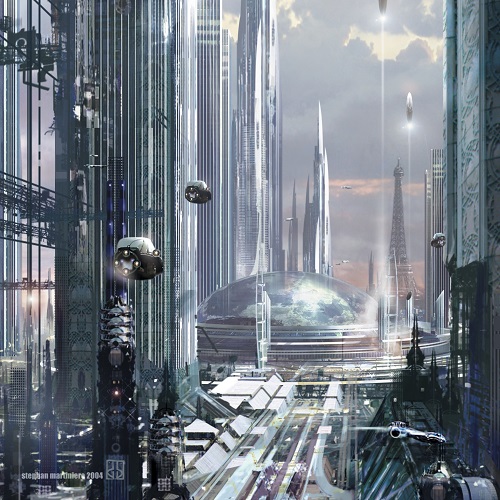
Figure 1 – Stephan Martiniere (http://www.martiniere.com) – Selected to accompany a not-yet-published space.com interview – Used by permission
Because they can set trajectories and influence the tone of ongoing efforts, visualizations — even early on in a project — can be very potent, and important to conveying an understanding of the project’s potential. This realization was also behind the first FarMaker Speed Sketch contest, successfully carried out for Starship Congress 2013. Children, enthusiasts, and professional concept artists competed for prize money and recognition, painting and drawing and rendering speed sketches of starships, based on the Daedalus theme. (Speed sketches are a genre of concept art common throughout the entertainment and visualization fields, where rapid techniques are used to express the energy and essence of an idea in a visual form.)
At the moment, from our vantage point of stalled or listless efforts, cultivating new visions of an interstellar future may not make much sense to the broader public. But years from now, as our capabilities and motivations for action grow, (and presuming we endure) these efforts may prove key in sparking forward momentum. If this is true of interstellar aspirations, perhaps it could be true of Earthbound aspirations as well. The most pressing aspiration at hand is the drive to build — or even to see for ourselves and our world — a future in which Earth-originating life achieves its full potential. Of course, ideas and techniques applied in one area (such as the Vessel project) can be applied in other areas (such as eventual starship design), and vice versa.
The phenomenon whereby vividly articulated visions of alternate futures helps pave the way for their realization is not a new one. From Leonardo da Vinci to Jules Verne and on to our present day, we’ve long been aware that the inventions of the mind can unfold in the world when expressed for others to perceive. But currently, there is particular and renewed interest in describing and modeling future possibilities as thought experiments to test their viability. One term for this approach is Design Fiction; another is Science-Fiction Prototyping. Doctorow made the observation cited above in discussion with Brian David Johnson, as part of his work with sci-fi prototyping. Bruce Sterling has an extensive archive of writings on Design Fiction in its present form. At Arizona State University’s Project Hieroglyph, science fiction authors such as Neal Stephenson, Geoffrey Landis, Bruce Sterling, Cory Doctorow, and others explore the potential for speculative ideas to shape reality.
We’ll return to these related strategies in future installments. For the moment, however, we’ll stay focused on the basic power of concept art and visualizations for both informing and inspiring others, when working with a speculative proposal or technology. In the case of the Vessel project, my experience of the power of visualizations to clarify and galvanize understanding came early. At 100YSS 2012, for the first presented version of the Vessel proposal, I discovered that the single most effective element of my presentation turned out to be the visualization of the Lilypad seasteading habitat, designed by Vincent Callebaut. This visual anchor, once linked with the dedicated task of housing archives and labs, immediately sparked in session attendees a sense of form and function for the Vessel proposal.
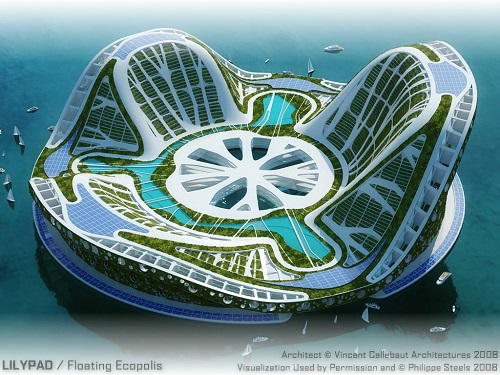
Figure 2 – Vessel as an instance of Vincent Callebaut’s Lilypad seasteading habitat, 100YSS 2012 and Starship Congress 2013.
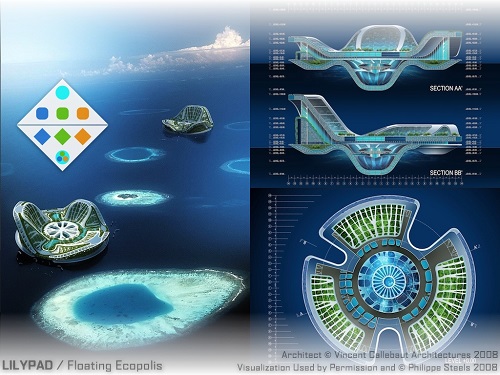
Figure 3 – Vessel as an instance of Vincent Callebaut’s Lilypad seasteading habitat (Cutaway and Details)
Upon seeing these slides, viewers later said, they had an instant sense of the proposal, and immediately understood more clearly what I meant (and didn’t mean) by a Vessel archive. This understanding was not merely important for building comprehension, or even for support. It also helped to set tangible limits to the problem space we were exploring, and the design solution I was proposing. A self-contained habitat may or may not be closed-loop; but in any case it is not in itself a sprawling city. If anything, it might be a facility within that city, or even a campus or complex within that city; but it had limits and an overall, centrally-focused, form. A Vessel habitat could easily be envisioned as a module on a starship, or an orbital station, or an Arcology (as per Paolo Soleri), or other similar forms.

Figure 4 – Arcology, architectural ecology: The city as space station, envisioned by architect Paolo Soleri, 1969.
These design limits help shape the debate: How do you provide energy to such a habitat? Are there technologies not viable on a very large scale which could be used for smaller, mission-critical facilities? What is its likely maximum scale or size? Importantly, what would it look like if different versions were built in a variety of settings?
For Starship Congress, I decided to visualize a Vessel installation in a few more forms. The goal was to express that a Vessel could be “massive as habitats, with others more like sculptures, compact and dense as a room.” One goal for 2014 is to develop the Vessel Open Famework, a Creative Commons (CC BY-SA) document which would sketch out the fundamental aspects and design patterns for a Vessel installation, in such a way that others could evolve and adapt them to fit their unique requirements. So, for the first time, I began to sketch out first guesses at functional schematics: What functions were key and core, and what types of spaces did they imply? The idea that outer layers would be (in the near term) public-facing and fairly welcoming, while inner spaces would be highly specialized and include mission-critical archives, had been there since 2012. Yet the idea of an Open Framework — as a practical, realizable working document available for anyone to adapt — evolved from this task of identifying a minimal set of functional spaces, each forming and informed by its neighbors.
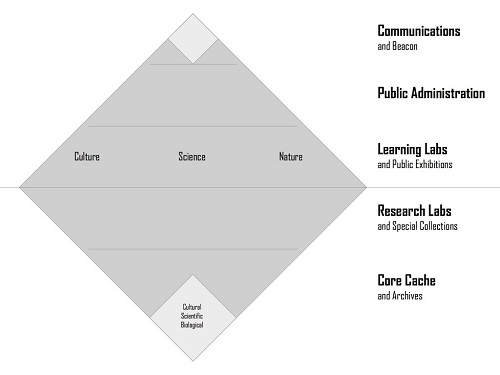
Figure 5 – Vessel Open Framework: Draft functional schematic, Starship Congress 2013
Open Source is an often-misunderstood form of intellectual property. Creative Commons does not prevent the creator from selling or making a profit from their work. The extent of shared content is flexible and depends on the license chosen. The preferred license for the Vessel framework, the CC BY-SA License specifies that you can do whatever you like with the design, including commercialize any results or adaptations, so long as you also pass on the right to do the same to those who next encounter your own derivative work. This flavor of open licensing does not negate the ability to commercialize, but rather removes any artificial scarcity from its core value so that the original design can be applied as widely as possible, and its true value determined.
From the perspective of Xrisk mitigation, aiming for open source distribution of the core framework has been a simple, nearly inevitable, decision. Earth-originating life faces a variety of complex challenges having complex causes; it stands to reason that partial solutions may be found across many different domains. Because we cannot know where risk-mitigating solutions will be pieced together from, and because the stakes are so high, it is essential to remove barriers to sharing and access wherever possible. The stakes at work when dealing with Xrisk define a large playing field. On that field, eventually, open source of some kind or another is an inevitable development if we are to truly test our most viable strategies as widely as possible.
With a document sketching out the Vessel Open Framework firmly in mind as a goal for 2014, I wanted to offer up a simple but compelling baseline design to speed future work. I wanted a simple shape and form which said to others, ‘This is a very simple starting point, which is probably not ideal for a final architecture, but which is intriguing enough to spark new interpretations.” The shape and form which resulted is that of a simple cube, tilted and sunk halfway into the groundplane, so that three overhanging entries are visible, a peak (perhaps housing communications or power arrays) is clear, and the iceberg-like sunken mass of half the structure underground is implied, just waiting to be explored. While it bears a passing resemblance to the pyramid, these other implications (understories for deep archives; three enties into three collections based on nature, science and culture) are also there to be inferred.

Figure 6 – Cubic Vessel
While I had developed this concept before Starship Congress, I did not have the wherewithall to realize images of this shape before the presentation. Upon returning home, I set to work with two artists I had come to know in the months leading up to the event. Together, Mark Rademaker and Joshua Davis have yielded some intriguing first glimpses of this strawman shape for further development. Pictured below, these rough first versions need one key preface: By the time we set to work, I had become excited by the possibilities of beamed solar power as a dedicated source due to several sessions at Starship Congress, but I had no clear idea what working beamed solar would look like. Additionally, I had become curious (during Day 1’s discussions of beam riders) about the question of whether communications and power / propulsion could be carried on a unified beam, and all of this collided in some very romanticized beaming in the first Cubic Vessels below.
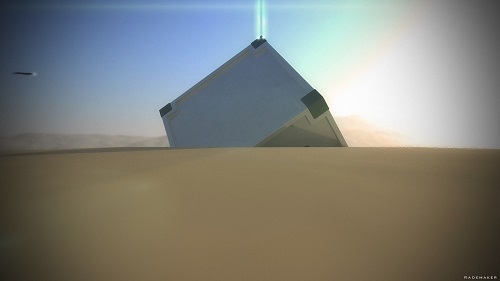
Figure 7 – Cubic Vessel with Naive Beamed Solar Power and Communications Signal – Mark Rademaker
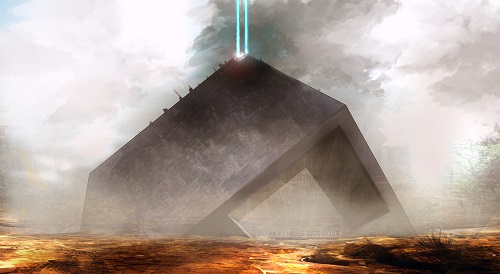
Figure 8 – Cubic Vessel with Naive Beamed Solar Power and Communications Signal – Joshua Davis
In discussions with Lt. Col. Peter Garretson, who delivered an inspired talk at the end of SC Day 3 in which beamed solar figured prominently, I was led to some more realistic interpretations of beamed solar power in the near term. (See below.) While not central to the Vessel Open Framework, the idea of dedicated energy is compelling enough as a backup or failsafe to be well worth visualizing realistically. A discussion of dedicated power for a Vessel facility is planned for future installments.
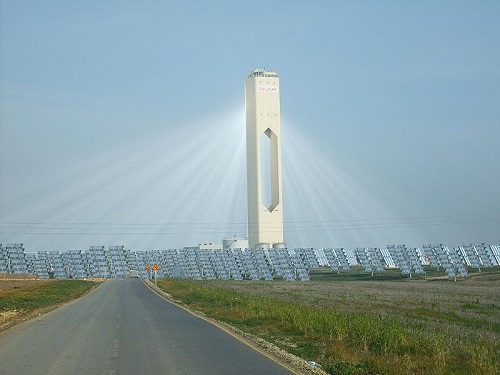
Figure 9 – Solucar – Concentrated solar receiver (Wikimedia Commons)

Figure 10 – Gemasolar – Concentrated solar receiver (Wikimedia Commons)

Figure 11 – Cubic Vessel with Concentrated Solar Receiving Beacon – Joshua Davis
From a growing understanding that these visualizations will be continually refined, we have begun to move towards more flexible frameworks. No visualization is final, and we continue to try new ideas as we gather resources on proposals for long term archives, and the sustainable societies which would be gathered there to miantain them.
Below is pictured Joshua Davis’ recent rendering of a lunar vessel, its receptor at the peak and its habitats built beneath the lunar surface, below a massive reflective array which nourishes the mission-cricitcal collections of the Vessel itself.

Figure 12 – Cubic Lunar Vessel with Concentrated Solar Receiving Beacon – Joshua Davis
Onwards we move, slowly building a unified design pattern language for the Vessel project, visualizing as we go. An inspiring image, even of something impossible here and now, can move the mind to spot new connections and bring them to bear on the problem at hand. In future articles, we’ll continue to explore other aspects of this work, such as discussions with Lt. Col. Garretson on potential locations for Vessel infrastructures, correspondence with USD’s Danieh Sheehan on the viability of hardening a Vessel’s power infrastructure against massive solar events, and the practical question of how we might build one using existing technologies if we had (say) 24 months til critical need.
For now, I welcome comments and reflections on the hypothesis that where vision and visualization leads, the mind and will can often follow.



A very important person in the film, then theme park industry, Walt Disney, always used concept art, and miniatures to realize his dreams and inspire others. The art and dioramas were instrumental in inspiring his sponsors, engineers and then the world to make Disney Parks the biggest theme park operation in the world. EPCOT was one of his most ambitious projects, unfortunately after his death the project was put on the back burner and never emerged as Walt intended it. A true futurist, if Disney was still alive, I think we could be closer to some of these projects than we are today! Some of these concept drawings remind me of those for Magic Kingdom at Disney World!
Some thoughts:
1. It looks like your beamed power is in the optical frequencies. For vessels on earth, you probably want microwave frequencies instead. The receiving antennas then look more like chicken wire and could possibly be part of the vessel wall structure rather than dedicated receivers.
2. I’m not clear why you like the tilted box design so much. Wouldn’t a design that can more naturally grow in size make more sense, i.e. one that can encompass ever larger archives and resources, rather than what looks like the final size of the building? I see a similar problem in the lily pad structure too. Cultural knowledge and artifacts will continue to grow and possibly outgrow the structures.
3. To survive the sorts of existential catastrophes you envision, the building should be mostly subsurface, albeit with obvious access points, including simple stairways. You may also consider geothermal power in case the beamed power supply fails.
4. Single points of failure are not good. How can the design be easily replicated with obviously decodable information about the location of other vessels? For example, should each have information about the exact location of others, or even design elements like corridors that point in the direction of other vessels?
5. Should each vessel be all-encompassing, or specialized, more like museums are today, with some small number N needed to cover all the specialties?
6. In the case of a massive catastrophe where all surviving languages are very different from those in the archives, or aliens are the visitors, what thoughts do you have for helping with decoding the stored cultural information? (This may be beyond the project’s scope).
Bookmarked this exciting post….
Bookmarked Stephan Martiniere’s painting of a futuristic city I might as well name Atlantis….an Atlantean fragment of our next civilization….upon seeing the cubic vessel art, the pyramidal starship on Stargate doesn’t seem so ridiculous after all….it’s all about having unlimited energy….
@Alex, great questions. Some responses to keep thoughts in motion:
1 – Agreed on beamed power; those visible beams are very naive, coming from a early attempt to picture just what such a system could look like if it were also sending information signal outwards. The more recent designs home in on concentrated light, with the walls covered in some sort of receptive material. Can you point me to an image of the ‘chicken wire’ mesh in action?
2 – The cubic vessel is a straw-man design, meant to be intriguing though never fully satisfying; a catalyst for attempts to do better. I will say that when I first saw it in the mind’s eye, it was startling and evocative. I’d been playing with truncated triangles and with diamond shapes for some of the symbology (https://centauri-dreams.org/wp-content/uploads/2013/08/fig-09.jpg) and I was fascinated by the idea that a three-entry and seemingly three-sided pyramid could feel more dynamic and less complacent than a four-sided pyramid. I was also attracted to the idea that once you’ve taken the shape in, it becomes clear that there’s as much below as above. Though tricky to flesh out inside, certainly there are more complex architectural forms being carried out today. (For instance: http://www.archdaily.com/80309/denver-art-museum-daniel-libeskind/ )
All that said, I suspect and hope that the cubic vessel is just one of many possible interpretations to come. To me, the idea of a dome seems nearly inescapable, (https://centauri-dreams.org/wp-content/uploads/2013/10/fig-01.jpg or the Eden Project at http://upload.wikimedia.org/wikipedia/commons/f/f2/Eden_Project_geodesic_domes_panorama.jpg) — even if it wouldn’t always be as legible from a distance as a designed form. Perhaps that could be a plus. A dome, of course, could likewise imply as much or more below ground as above, if it were part of a sphere. But the short answer to “why the tilted cube” is simply, “Because it made an galvanizing and evocative starting-point, which I could see releasing ‘for free’. It implied both problems and novel solutions. Etc. But only a spark and a seed.
3 and 4 – The fully-accessible form is envisioned as a Vessel facility in the flush of a functional society, as a kind of hybrid learning center and archive. Think of what a Nature & Science Museum is today, and add all the functionality of a mission-critical archive and laboratory. Of course, such sites are hardly secure in a crisis and it’s a given that massive redundancy would be ideal. Perhaps any given Vessel has a sibling, built to the same specs, but somewhere unknown. Certainly in a far future or recovery / rediscovery scenario, I’d agree that most of such a facility would need to be uncovered — literally — to be accessed.
I’d imagine a building complex, more of a campus, as being more practical — and this likely under some sort of habitat-sheltering shell, such as a dome. Such a campus or collective of nearby structures would need to grow and shrink as you suggest. No single form could possibly serve all needs. It’d be nice if all core Vessel facilities were somehow scalable. I’ve envisioned the cubic vessel as a structure no larger than a garage-apartment as well as of gargantuan size. The difference between a hidden cache and a habitat. Eggs in many baskets.
4, 5, and 6 – Decoding and redundancy: This to me is one of the most intriguing aspects of an open-source approach which could be applied in many ways in many places, and is very much within the project’s design scope. Every site would be unique because no centralized authority could control (or should) what any local effort chooses to preserve as core to their society. Yet I’d hope that all of them, to some degree, would ‘contain the whole’ through random sampling and sharing of archives, but also through a healthy diversity of materials at each site. And I’d like to think that each could contain part of the means to find and recover the others.
To be honest, there is room for layers of decoding that’d need to happen (that explorers or visitors would need to be savvy enough to do) which revealed more of the core information, and more about its sibling Vessels elsewhere. As design fiction, there are some game-like aspects that I’d love to explore in a kind of simulation. If you’ve played the game Fez, or any of the Myst games, this kind of slow uncovering and decoding shouldn’t seem that far-fetched to design.
One goal for 2014 is to explore fleshing out a simulation-like or explorable (even possibly game-like) version in a 3D suite like Unity3D. For that, though, I’ll need a team… :) I’m thankful to Mark and Joshua for their enthusiasm in helping to visualize things this far. But more variations on a basic form are certainly needed.
@Heath – one thing I really like about faceted buildings is that they are obviously artificial. It has s been suggested in other threads that these are just the sort of features that might be detectable from a great distance, especially if they have an unnatural coating, like gold. It is always a balance of course. The pyramids are faceted, and their surface casing stones have long since been stripped for other purposes, leaving just the granite and limestone blocks. So I think you are right to have at least a surface feature, even if the bulk is subterranean.
Contrast that with more natural looking burial mounds that merge into the landscape. One can imagine them being completely lost when forestation returns to the sites. Of course even pyramids can be buried in sand, or in the case of Central American ones, crumble and and fall into ruin in the jungle.
Avoiding an organic architecture is probably best for rediscovery and recovery. Or alternatively, make them easy to hide, but with some sort of transmission to signal their presence to people of different technology levels, possibly even at strengths suitable for aliens doing SETI. A mixed strategy may even be better.
I really like the gaming idea! I hope you can expound on that initiative in another posting.
“Cory Doctorow, author and open source advocate, has said that if we want to change the future, we need to change the stories people tell themselves about it. As discussed in my first article on the Vessel proposal, culture is well accustomed to visualizing dire possibilities, particularly those of Xrisk subtype Permanent Stagnation. Yet if all you have is a hammer, everything looks like a nail. ”
However, I note that one of the main purposes of the Vessel is to serve as a facility for preserving mankind’s legacy. To some this project itself might be construed as a visualization of dire possibilities. How about visualizing a social/architectural project referred to as a sanctuary? It would be a city skyscraper where the inhabitants would have access to gardening areas and machine shops. With the lose of manufacturing in the U.S. and the growing poverty, many children (unlike my own childhood) have never had any exposure to a machine shop. These children may lack the background and resources that inspired and made possible the Wright brothers attempt at flight. Oddly like American prisons, one could live without cost at a sanctuary as long as one continued a educational process favoring one’s potential (for this reason sanctuaries could also be called prisms). The sanctuaries would attempt to be as self-sufficient and high tech as possible.
Patent and copyright development would be encouraged. Please read Plato’s Republic for other suggestions. The wave of the future could well be such city/states.
I’m not sure what is gained by the cubic look (reminds me of the Borg).
@ Heath – rectenna demonstration. You can see the wire mesh form of the antennas quite easily.
I think that something important to highlight from these artworks, is that they try to hit the focal intersection between architecture, terraformation and closed biospheres. There are no many architects that know too much about the engineering constraints of closed habitats for extraplanetary settlements, and no many engineers explore the aesthetical aspects of architectonic exploration. Art and aesthetics is essentially a tease, then it comes science and tries to rescue and materialise what it can
Something troubles me about these massive but apparently empty (I see no people.) constructions. They remind of Albert Speer’s architectural visions of the new Berlin, the capital of an ascendent third reich. The purpose evidently was to show the insignificance of the individual as diminished by the power of the state. In the case of these cubic vessels, I don’t have a clue how they relate to humans or the human condition. I hope that the 100 year starship project finds a positive way to relate to ordinary people. Perhaps more important than the building of the starship is what we plan on sending to the stars.
@Dick and @John – The borg have been brought up before, and in combination with the monolithic aspects mentioned by John, I see those connotations as one of the most negative aspects of this particular seed design. Of course, these are not the kinds of associations that will help the project to be understood, so they’re a big part of why we’ll continue to look for other basic forms in the future.
Because the goal of unique differences from one Vessel to another is key, the borg association is completely the reverse, and as far as pop culture goes, one of the reasons this particular design is likely not to go much further in its present form.
As for scale, this too was on my mind, but one of the challenges here is that I myself am not a visual artist! :) I’d been contemplating trying to do some renderings of my own showing doorways, balconies, vegetation, windows, and all kinds of other more human features, but I simply don’t have the rendering skills to pull it off yet. In the meantime, my collaborators were trying to just grapple with the basic form to start with.
Given that the cubic form itself is probably not viable — at least for the overall structure — maybe I need to have them read through these comments and we can head back to the drawing board on a more fundamentally approachable form.
The idea of this shape for an actual cache or container still intrigues me, but it’s time to let this shape sink down into the inner part of the design, at best, and look at — as John notes — what it is we are really trying to convey…
… To the stars, or simply to the future.
A quick follow up: There is an architecture publication, called eVolo, that does an annual design competition for speculative designs re-envisioning the skyscraper. (http://www.evolo.us/category/2013/ … http://www.evolo.us/category/2012/ … etc)
Given a basic premise and form, architects and artists are able to come up with some often outlandish but certainly creative takes on the basic form of a vertical building. Though a Vessel is imagined as not necessarily so vertical, it’s a very interesting approach to envisioning the future.
I’ve thought before how good it might be to try and do a Vessel Visualization Contest which took a similar approach: Given these basic functionalities, (facilities for creative and scientific discovery in the short term, archives housed for the long term, etc), what other basic forms are possible? if it can work for the form of the skyscraper, it could surely work here.
Perhaps I should speak to Paul about setting forth with a joint project..! ;)
@Reverend – That function of sanctuary or haven is definitely there in the proposal, though it an be tough to get the emphasis right. I do see long-term planning as optimistic, but also love the near term idea of a hands-on laboratory for learning sustainability (making things, growing things, discovering things).
The capability of a large structure to host a small society seems worthwhile to explore as part of the Vessel framework and hopefully we’ll do more.
A tangent is that all this talk of a settlement or even city-state as habitat made me realize that in fiction, J.R.R. Tolkien’s citadel of Minas Tirith could be seen as a Vessel. At its center was (though neglected in the time of the story) a wealth of learning, lore, and knowledge. But surrounding it all was a living society.
As an artist, there are times when the work you are doing loses the freshness it once had in the sketch. The composition becomes flawed, the colors lose any type of cohesion… the “flow” disappears.
Prayers get offered to the gods and muses for inspiration. Drinks are drunk, music is listened to, books are read, movies are watched. Anything to “re-fresh” the pool of elusive inspiration. You sleep, dream, and wake… hoping something will click.
If you’re lucky during this time, someone will come by and say something that instantly kicks your ass and you know EXACTLY what the next step is…If you’re even luckier, you work around other artists, and the same event happens.
The best thing about working on the Vessel project is discussions like THIS.
It’s like dunking my head in a pool of clean, cool water and seeing the work from new eyes…
The cube felt distant, alien, and monolithic… I’ll agree on all those points.
But, as an artist and human, I loved the mystery about it. This stark, giant cube smashed into the landscape. The weight of it. Then, there were the overhangs, entries into the archives. They beg you to come closer, to see what’s inside, to explore and investigate.
There are other ways, more approachable ways, to achieve those things… The “cube” was a starting point… and I hope I’m not jumping the gun by linking to the last image of the “cube” that will get published (I think)…
This is a version where the Vessel presence is located within a larger future metropolitan environment. For whatever reason I kept thinking about 60s & 70s utopian sci-fi illustration while working on it, and it shows a bit.
http://theartofjoshuadavis.files.wordpress.com/2013/10/vesselutopiaweb.jpg
I think we may not have seen the last of the cubic vessel shape; if nothing else, as a symbolic stand-in for the core of the archives, where the most dense body of information is stored in some resilient form (holographic? crystalline?), I love its simplicity.
We’re now beginning to expand back outwards to more readable human forms for the havens surrounding any vessel core. But I love Joshua’s last rendering, and I’m with him that for me as well, this stark shape when it appeared to me was never ominous, but stirred my imagination. In that it has priority of place in the evolution of the Vessel project.